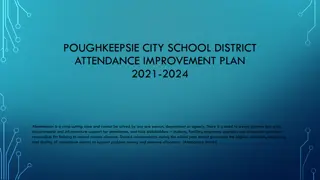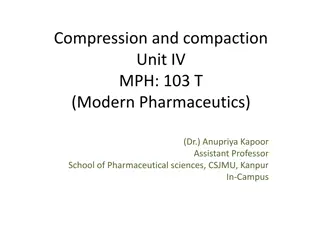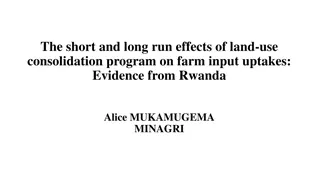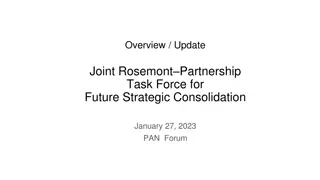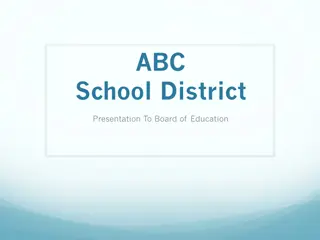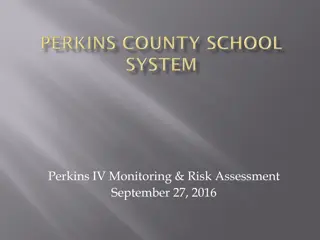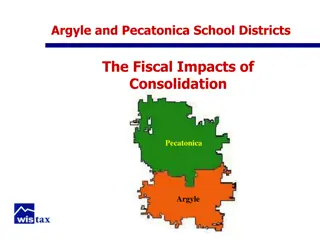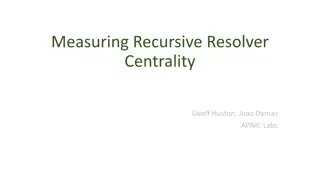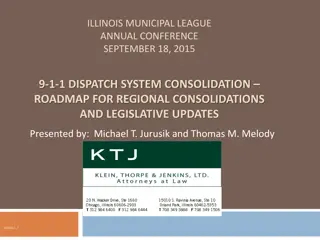School District Consolidation
This seminar delves into the history and implications of school district consolidation, exploring the potential economies of size and methodological challenges in estimating them. The session covers the impact of consolidation on education costs per pupil, historical trends, and various consequences of district reorganization. Join us to gain insights into the complex landscape of public finance in the education sector.
Download Presentation

Please find below an Image/Link to download the presentation.
The content on the website is provided AS IS for your information and personal use only. It may not be sold, licensed, or shared on other websites without obtaining consent from the author.If you encounter any issues during the download, it is possible that the publisher has removed the file from their server.
You are allowed to download the files provided on this website for personal or commercial use, subject to the condition that they are used lawfully. All files are the property of their respective owners.
The content on the website is provided AS IS for your information and personal use only. It may not be sold, licensed, or shared on other websites without obtaining consent from the author.
E N D
Presentation Transcript
Public Finance Seminar Spring 2021, Professor Yinger School District Consolidation Based on Research by William Duncombe and John Yinger
Class Outline Economies of size and school-district consolidation Methodological challenges in estimating economies of size in education Other consequences of consolidation
Class Outline Economies of size and school-district consolidation Methodological challenges in estimating economies of size in education Other consequences of consolidation
History of Consolidation Consolidation has eliminated over 100,000 school districts since 1938. This is a drop of almost 90 percent. Consolidation continues today, but at a slow pace. Consolidation is a big issue in state aid programs. Several states have aid programs to encourage district reorganization, typically in the form of consolidation Other states encourage consolidation through building or transportation aid About 1/3 of the states compensate school districts for sparsity or small scale thereby discouraging consolidation.
Economies of Size and Consolidation Economies of size exist if education cost per pupil declines with enrollment. Consolidation lowers cost per pupil if there are economies of size. Previous studies estimate cross-section cost functions. Most find a U-shaped relationship between cost per pupil and size No previous statistical study looks at consolidation directly This study estimates economies of size using panel data for New York State. The data include all rural school districts, including 12 pairs that consolidated The sample period is 1985 to 1997 D/Y estimate economies of size (and other cost effects of consolidation) with panel methods. (EF&P, 2007)
Are There Economies of Size? Potential Sources of Economies of Size Indivisibilities (i.e. Publicness) Increased Dimension (i.e. Efficient Use of Capital) Specialization Price Benefits of Scale Learning and Innovation Potential Sources of Diseconomies of Size Higher Transportation Costs Labor Relations Effects Lower Staff Motivation and Effort Lower Student Motivation and Effort Lower Parental Involvement
Questions What are economies of size in public production and how do they show up in a public cost function? What are the potential causes of economies of size? What are diseconomies of size and why might they arise?
Class Outline Economies of size and school-district consolidation Methodological challenges in estimating economies of size in education Other consequences of consolidation
Estimating Economies of Size The article by Duncombe and Yinger provides a comprehensive look at the issues that arise in estimating the impact of school district consolidation on the cost of education, including estimates of economies of size.
The Cost Model in Duncombe/Yinger E = E{S, P, N, M, C, Z} E = spending per pupil (total or in a subcategory) S = school performance (test scores, dropout rate) P = input prices (teacher wage) N = enrollment M = student characteristics C = consolidation Z = variables that influence school-district efficiency Data for 212 districts over 13 years.
Methodological Challenge #1 Challenge: Consolidation might be endogenous. Response: Use district-specific fixed effects Use district-specific time trends Control for change in superintendent Standard simultaneous-equations procedure not feasible; use a control function as final check
Structure of D/Y Fixed Effects District Year Fixed Effect for District A Fixed Effect for District B Post- Consolidation Fixed Effect for Pair 0 0 0 1 1 1 0 0 0 1 1 1 A 1 1 0 A 2 1 0 A 3 1 0 Consolidation: 4 A 0.33 0.67 A 5 0.33 0.67 A 6 0.33 0.67 B 1 0 1 B 2 0 1 B 3 0 1 Consolidation: 4 B 0.33 0.67 B 5 0.33 0.67 B 6 0.33 0.67 Notes: The dependent variable for district i is expenditure per pupil in district i (before consolidation) or in the combined district of which district i is a part (after consolidation); in this example, district A has 33% of the total enrollment in the two districts the year before consolidation (year 3).
Implications of Fixed Effects & Time Trends Because consolidation is a long process, not an event, we believe this approach is adequate protection against endogeneity. This approach highlights the impact of enrollment change. This price is that we cannot estimate the coefficients of other variables with precision.
Methodological Challenge #2 Challenge: Consolidation may have non-enrollment effects that change over time. Responses: Include post-consolidation fixed effect for each pair Include post-consolidation time trend for each pair
Methodological Challenge #3 Challenge: Performance, teacher salaries, and state aid are endogenous. Responses: Use two-stage least squares Select instruments from exogenous characteristics of comparable districts (e.g. income and aid in neighboring districts, manufacturing wage) Conduct over-identification test Conduct weak-instrument test
Methodological Challenge #4 Challenge: Capital spending and associated state aid are lumpy. Responses: Use 4-year averages in capital spending regression (for spending, enrollment, aid, property value) Adjust fixed effects and time trends Adjust post-consolidation fixed effects
Conclusions, Part 1 Operating Costs Thanks to economies of size, consolidation cuts operating costs for rural school districts in New York by up to one-third over 10 years. Adjustment costs exist, but they phase out quickly over time except in transportation. The cost savings are largest when consolidation combines two very small districts; two 1,500-pupil districts can only save 14 percent per pupil.
Conclusions, Part 2 Capital Costs There are no economies of size in capital spending. The state aid that accompanies consolidation raises inefficiency so that no capital cost savings result. This short-run inefficiency increase may be partially offset by long-run increases in student performance.
Policy Implications Encourage Consolidation New York, and probably many other states can lower education costs by encouraging school districts to consolidate. Focus on Small, Rural Districts Consolidation incentives should concentrate on small districts; the benefits of consolidation disappear for consolidated districts above about 4,000 pupils. Be Careful to Monitor Capital Spending and to Minimize Aid Changes After Consolidation State policy makers should not encourage (or even allow) wasteful capital spending in recently consolidated districts.
Questions The decision to consolidate is made simultaneously with decisions about spending. How can this endogeneity be addressed in a cost-function study of consolidation? How can a study of consolidation handle effects not associated with enrollment? How can a study of consolidation handle the endogeneity of student performance, teacher wages, and state aid? How can a study of consolidation handle the lumpiness of capital spending and associated state aid?
Class Outline Economies of size and school-district consolidation Methodological challenges in estimating economies of size in education Other consequences of consolidation
Other Possible Consequences of Consolidation Cost equations cannot measure Losses of consumer surplus Higher transportation costs for students and parents Changes in dimensions of school performance other than test scores and drop-out rates Consolidation is a choice Net benefits must be positive But they need not equal cost savings Property value impacts provide one measure
Estimating Other Consequences: Hu and Yinger, NTJ 2008 Regress Change in House Value (Tract Level) on Consolidation (Plus Controls) Interact with enrollment to pick up scale economies Control for change in state aid to pick up other effects Treat consolidation as endogenous, using consolidations in 1960s and number of districts, both at county level, as instruments.
Estimating Other Consequences: Hu/Yinger, Continued Results Consolidation raises value in small-enrollment districts Net benefits run out at about 3,000 pupils After controlling for state aid increases associated with consolidation, net benefits run out at about 2,000 pupils Even in small districts, net benefits are negative in high-wealth tracts
Estimating Other Consequences: Duncombe, Yinger, and Zhang, PFQ 2016 This article is based on house sales in upstate New York State from 2000 to 2012. Double sales are used to difference out time- invariant unobservables. Consolidation occurred in three sets of districts. Propensity score matching (PSM) is used to make sure the with- and without- consolidation observations are comparable.
Duncombe, Yinger, and Zhang, 2 The key intuition for PSM: The impact of a program or event may depend on other variables. So if the with- and without-program samples have different values for other variables, estimates of program effect may be biased. PSM is a technique to ensure that the two samples have the same distribution of other variables, so this bias disappears. PSM does not account for unobservables.
Duncombe, Yinger, and Zhang, 3 Findings Except in one large district, consolidation has a negative impact on house values during the years right after it occurs This effect then fades away and is eventually reversed. This pattern suggests that it takes time either for the advantages of consolidation to be apparent or for the people who prefer consolidated districts to move in.
Duncombe, Yinger, and Zhang, 5 Findings, Continued As in previous studies, the long-run impacts of consolidation on house values are positive in census tracts that initially have low incomes, but negative in high-income census tracts, where parents may have a relatively large willingness to retain the nonbudgetary advantages of small districts.
Questions What can be learned from a study of the impact of consolidation on property values that is not captured by a cost-function study of consolidation? Why is it important (at least in NY) for a study of consolidation and property values to account for changes in state aid? How can a study of consolidation and property values account for unobservable determinants of house values?
Supplement: D/Ys Instruments for 2SLS (performance and teacher wage are endogenous) For the operating cost models, the final set of instruments includes the log of average values of per pupil income and per pupil operating aid in adjacent districts and the log of average private sector wages, the log of average manufacturing wages, the unemployment rate, and the ratio of employment to students in the district s county.
Supplement: D/Ys Control Function Estimation (for potential endogeneity of consolidation decision) [O]ur logit model estimates the probability of consolidation in a given year as a function of the number of years since the previous consolidation in the same county, the preceding three-year change in the district s enrollment, the total state aid ratio in districts with similar enrollment, and the instruments identified for our cost regression.
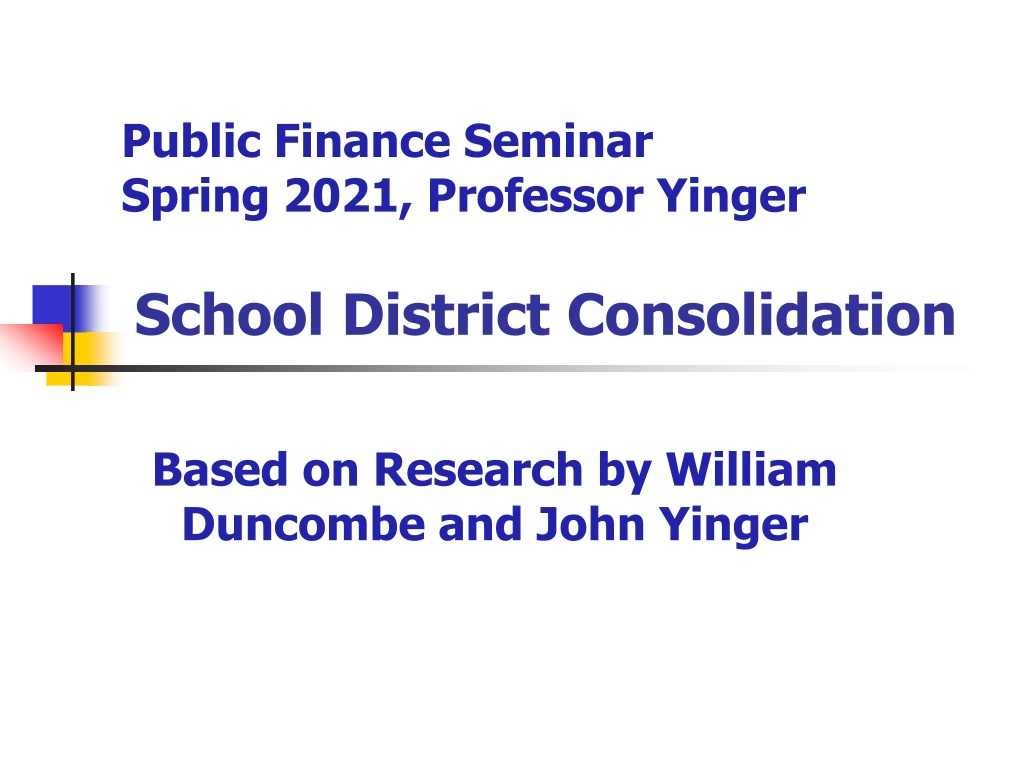
 undefined
undefined










